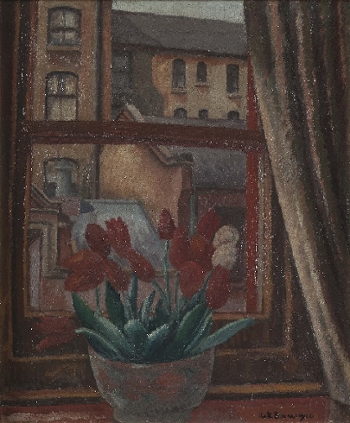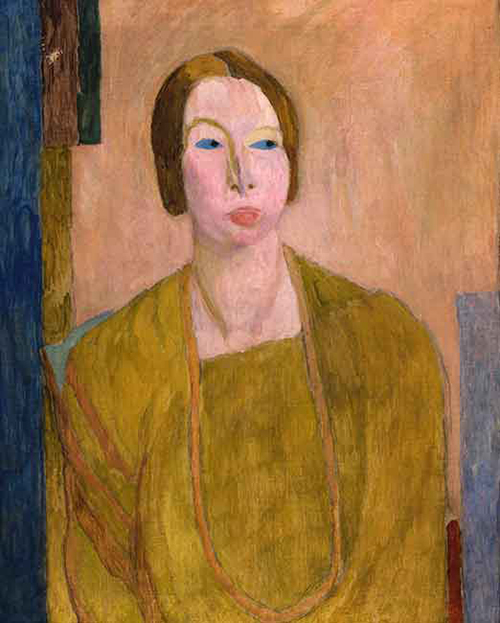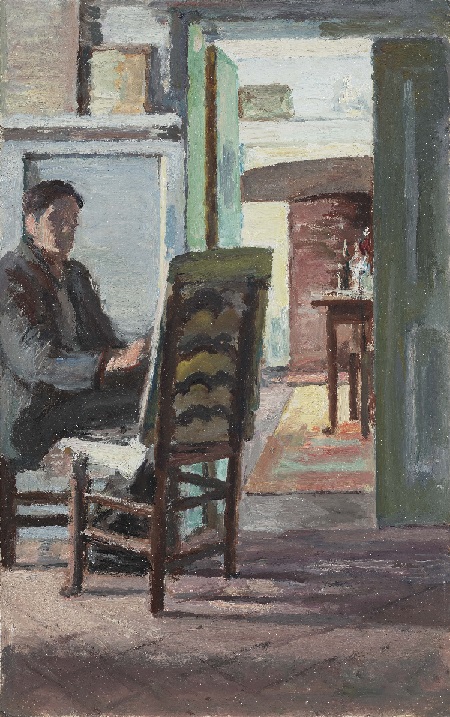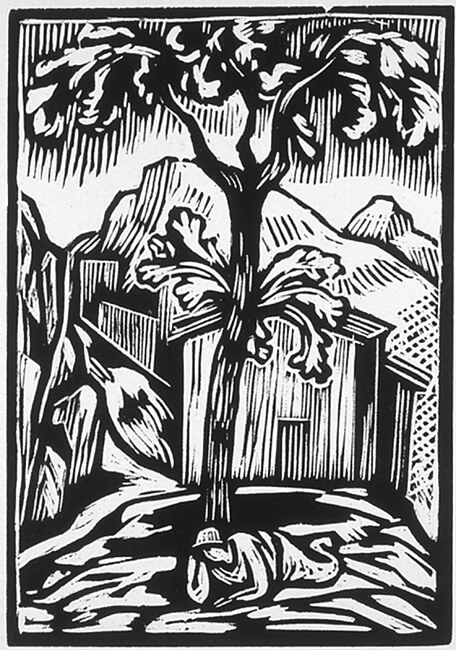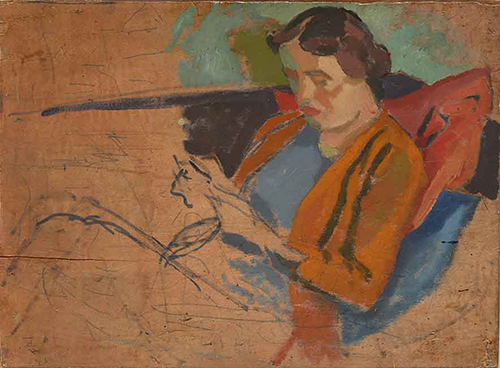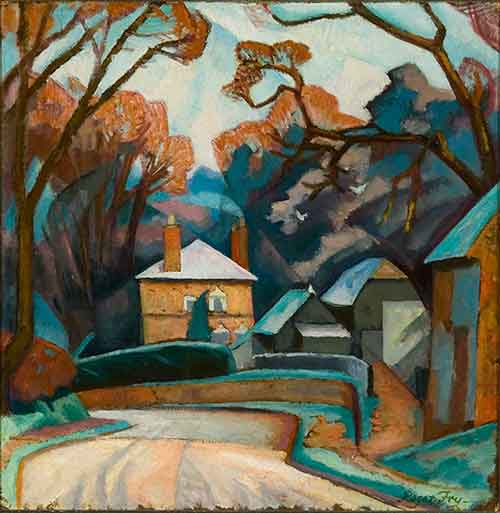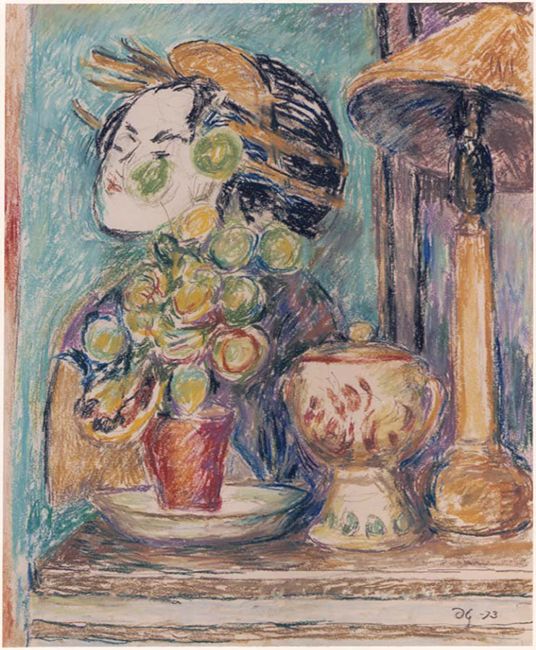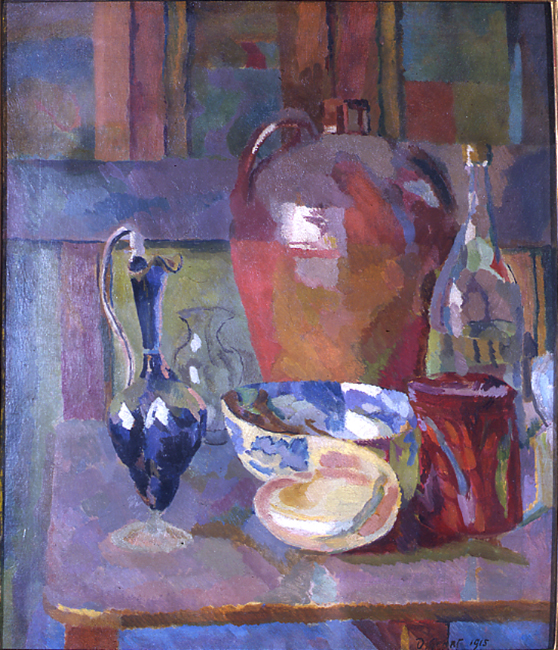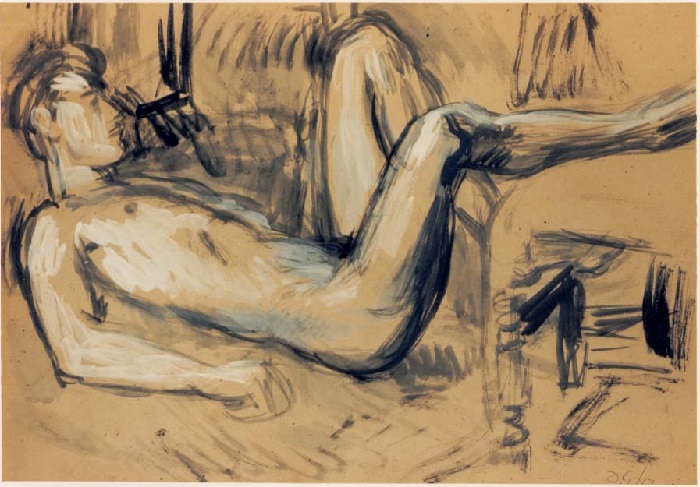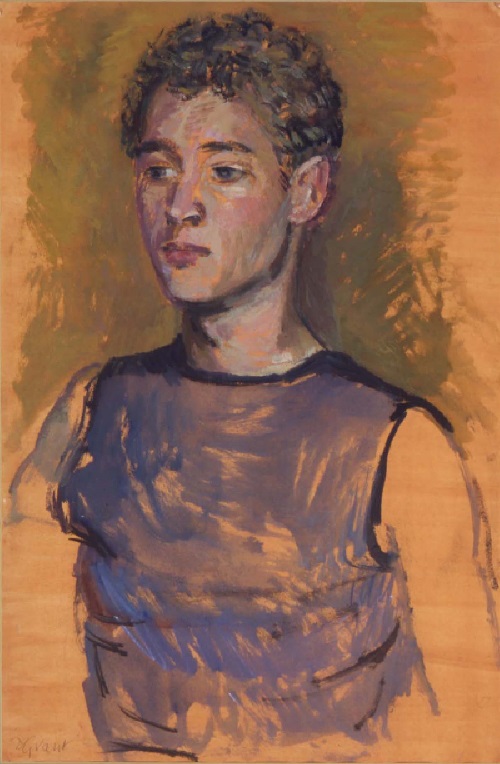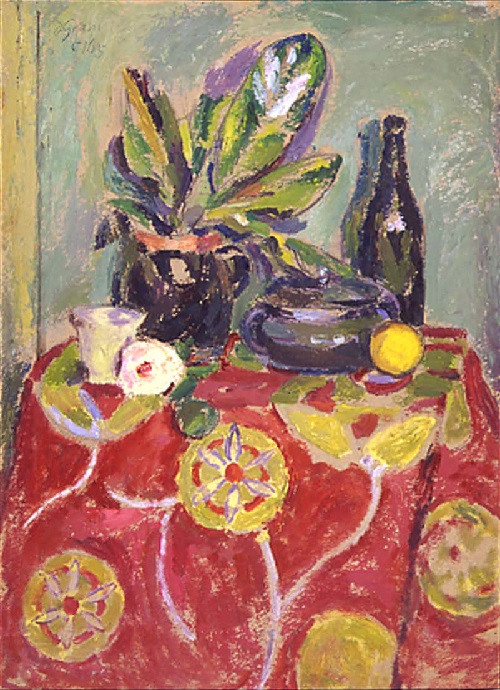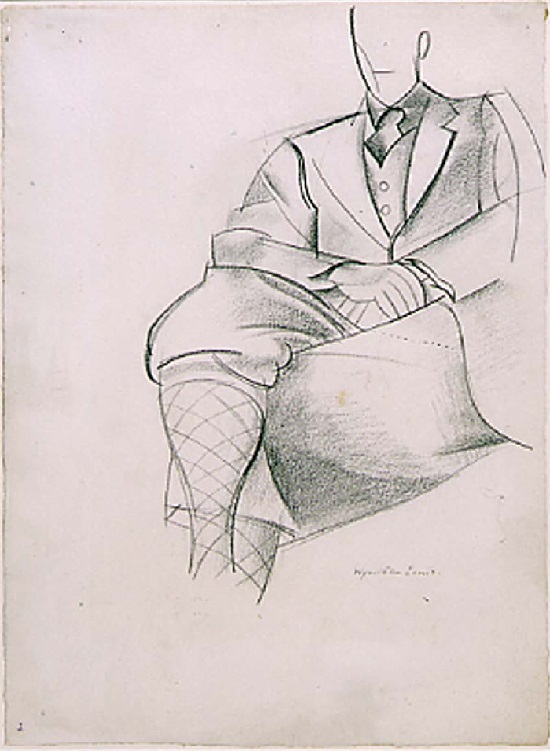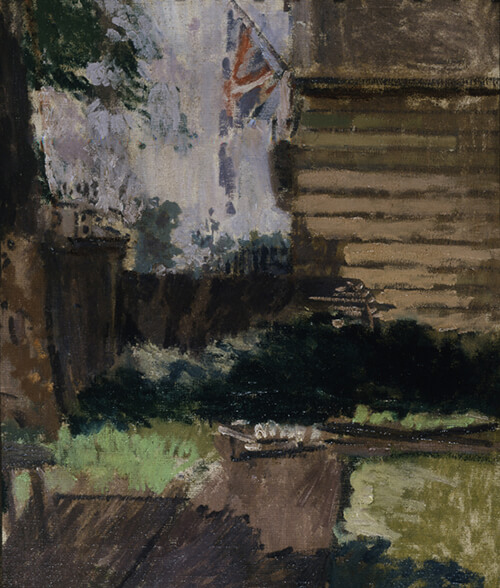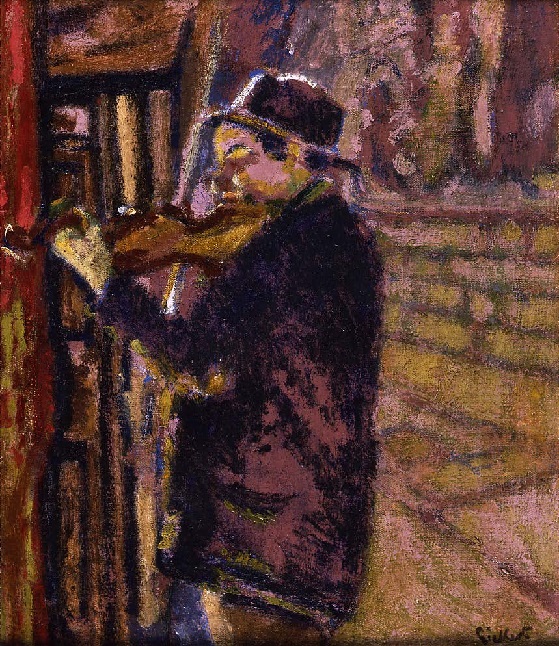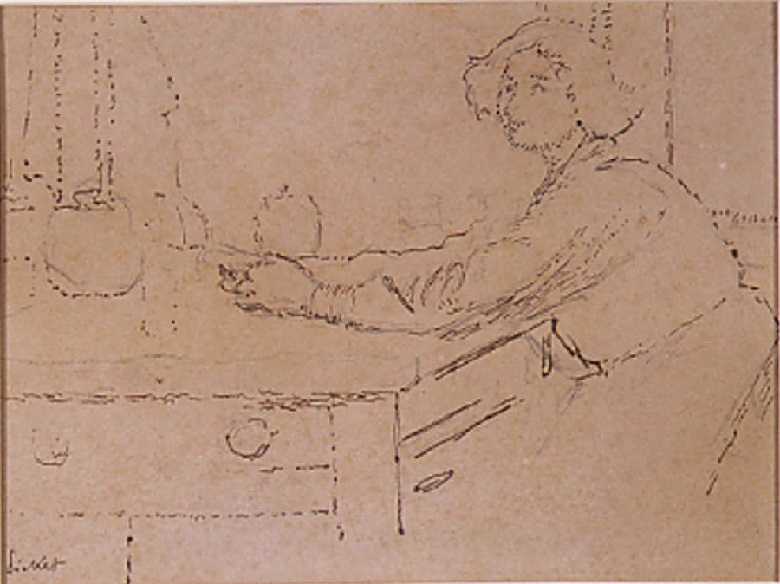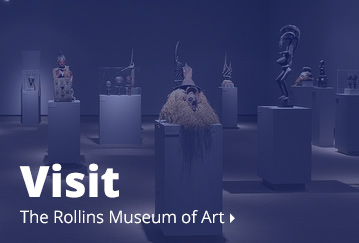Bloomsbury Group
Dr. Kenneth Curry ’32 named his alma mater as his major beneficiary. Alongside an endowed professorship in literature and an endowment for the Olin Library, much of Dr. Curry’s legacy was to benefit the Rollins Museum of Art. The majority of the works he donated to the museum are by the 20th century English artists known as the Bloomsbury Group, among them Vanessa Bell (1879-1961), Roger Fry (1866-1934), Walter Richard Sickert (1860-1942), and Duncan Grant (1885-1978). It was his love of English literature that led him to collecting: he had always been interested in “English painters who were also writers, or who belonged to a coterie of writers and artists… The Bloomsbury Group fits into this pattern – with its varied group of painters, novelists, essayists, as well as public figures.” At the same time, Dr. Curry created an endowment “for the benefit of the museum, the income to be used as an acquisitions fund for the purchase of pictures.” This was the very first fully endowed fund specifically for art acquisitions.
PLEASE NOTE: Not all works in the Rollins Museum collection are on view at any given time. View our Exhibitions page to see what's on view now. If you have questions about a specific work, please call 407-646-2526 prior to visiting.
Artists Featured in This Section
Edward WolfeKeith Baynes
(British, 1887-1977)Still Life of Tulips on Window Ledge, ca. 1920
Oil on canvas
24 1/2 in. x 20 in.
Bequest of Kenneth Curry, Ph.D. '32
Vanessa Bell
(British, 1879-1961)Portrait of Mary St John Hutchinson, 1915
Oil on canvas
31 x 21 3/4 in.
Gift of Kenneth Curry, Ph.D.'32, 1998.14
Mary St. John Hutchinson (née Barnes) sat for both Duncan Grant and Vanessa Bell at 46 Gordon Square, the home that Vanessa Bell and Virginia Woolf had shared with their brothers Thoby and Adrian Stephen. Bell produced two portraits of St. John Hutchinson from this sitting; the other is now part of the Tate Britain collection. In all three portraits, the abstract background is similar, suggesting that Mrs. St. John Hutchinson sat before an abstract painting or Omega Workshops screen in the studio. The striking colors and intense presence of the sitter conveyed in the portrait mark this as one of Bell's best early paintings. The flatness of the picture plane, harsh juxtaposition of colors, and liberation of the veristic use of color all betray a strong influence of French Post-Impressionist art. As a leading member of the Bloomsbury Group, Vanessa Bell, like the other Bloomsbury artists, was powerfully influenced by Roger Fry's two Post-Impressionist exhibitions (1910 and 1912) that had shaken the London art world to its foundation. Vanessa's husband, Clive Bell, published the important text Art in 1914, in which he argued for a purely formal approach to the understanding and appreciation of art. For Clive Bell, "significant form," defined as line, color, and form, combined in particular ways within a work of art to produce the "aesthetic emotion." In this portrait, Vanessa Bell seems to have line, color, and form in the forefront of her mind. Mary St. John Hutchinson was a very wealthy socialite who mixed with the highest society. However, she was herself quite brilliant and seemed to enjoy the intellectual engagement of the more bohemian Bloomsbury artists and intellectuals. She was an important patron of the Omega Workshops, and Vanessa Bell and Duncan Grant were called on several times to decorate her successive residences. Bell has captured a certain cunning in this portrait that is not entirely flattering. This point-of-view may have come out of the fact that Mary St. John Hutchinson was the mistress of Vanessa's husband, Clive.
Vanessa Bell
(British, 1879-1961)Duncan Grant Painting, ca. 1952
Oil on board
18 in. x 11 3/8 in.
Bequest of Kenneth Curry, Ph.D. '32
Roger Fry
(British, 1866-1934)Saint Agnes, 1921
Woodcut
5 x 3 1/2 in.
Purchased with the Kenneth Curry Acquisition Fund, 1996.18
This woodcut appears as Plate V in Roger Fry’s Twelve Original Woodcuts, a book published by the Hogarth Press in 1921. Leonard and Virginia Woolf printed each of the volume’s illustrations by hand. The first edition of 150 copies sold very quickly and the press subsequently released two small editions soon thereafter. This image relates to Fry’s painting, Figure Resting under a Tree, St. Agnes (1915), created during a visit to southern France. Pippa Strachey, an acquaintance of the artist, served as the recumbent model.
Roger Fry
(British, 1866-1934)Study of Vanessa Bell Reading (Unfinished), 1912
Oil on board
18 1/2 x 21 1/2 in.
Bequest of Kenneth Curry, Ph.D. '32, 2000.1.9
As an artist, art critic, and one of the leaders of the Bloomsbury Group, Roger Fry helped to bring attention to and poularize modern art in Great Britain during the early twentieth century. Although unfinished, Study of Vanessa Bell Reading is an excellent example of how the Bloomsbury artists drew from various artistic movements and were deeply influenced by Post-Impressionism. Fry's surprising and bright color palette and the freedom of expression employed in his use of line are exhibited in this composition. The muted blue Fry employs for a shadow offers a contrast to the painting's more dominant color scheme of warm oranges and browns. As with much of his work, it is clear that Fry's own feelings are present in the study; he and Bell were lovers at the time, and his tenderness is visible in the unfinished portrait.
Roger Fry
(British, 1866-1934)Winter Landscape, 1912-1914
Oil on canvas mounted on board
20 x 20 in.
Bequest of Kenneth Curry, Ph.D.'32, 2000.1.10
Known to many students of art history as an art critic, Roger Fry was also a curator, and as this works proves, a talented painter. Fry was a member of the influential Bloomsbury Group, comprised of painters and writers who helped bring modernism to England and were active primarily from 1907 to 1930. In this painting, Fry demonstrates his reverence for Post-Impressionism and the influence of the French painter Paul Cézanne. In particular, the repetition of simple triangular forms that delineate the roofs of the houses suggest Cézanne's canvases. The Rollins Museum of Art has a number of paintings by Bloomsbury artists which were generously given to the Museum by Dr. Kenneth Curry, who possessed an ardent passion for and knowledge of the Bloomsbury Group.
Duncan Grant
(British, 1885-1978)The Fireside Table, Charleston, 1973
Pastel
20 x 16 1/2 in.
Bequest of Kenneth Curry, Ph.D. ’32, 2000.1.15
Duncan Grant’s body of work as a painter is eclectic and mercurial. His sensibilities were always very much his own, however much he was indebted to the profound changes brought by art’s breaks from tradition in the early twentieth century. This idiosyncratic pastel painting sets a colorful but traditional still life before a puzzling background. Behind a bouquet of flowers is a Japanese female face that could have been inspired by the Ukiyo-e prints of Hiroshige or Hokusai. A document from the 1990s in the Cornell object file states that “It depicts an Oriental lady behind a table.” It is more likely meant as a picture within a picture, an homage to the Japonisme of earlier European modernist art, as well as a witty reminder of painting’s inherent flatness.
Duncan Grant
(British, 1885-1978)Still Life With Salt Glazed Pitcher, 1915
Oil on Canvas
28 3/4 x 24 1/4 in.
Bequest of Kenneth Curry, Ph.D, '32
Duncan Grant was one of the visual artists among the Bloomsbury group, a circle of intellectuals in the eponymous central London district. Arguably the most gifted and inventive of the Bloomsbury artists, his style ranged from a vaguely Pre-Raphaelite mixture of Realism and Romanticism to a highly simplified, severe modernism.
Still Life with Salt Glazed Pitcher is a luminous treatment of ordinary kitchen table objects, in which he experimented with the interplay of warm and cool colors as a means of indicating volume and depth. He employed a subdued but varied palette in which the warm and cool colors provide an illusion of three-dimensionality. However, in Grant’s still life, it is not just the “temperature” of the colors that suggest recession into space, but the touches of white on the rounded forms of the large pitcher in the rear center and the small vase on the left. The geometric shapes in the background resemble some of Grant’s contemporary abstract works, in which entire compositions are devoted to angular areas of color.
Duncan Grant
(British, 1885-1978)Nude Study of Paul Roche, ca. 1951
gouache on paper laid on canvas
17 1/2 in. x 24 in.
Bequest of Kenneth Curry, Ph.D. '32, 2000.1.13
Duncan Grant
(British, 1885-1978)Portrait of Paul Roche, ca. 1950
Gouache
22 in. x 14 1/2 in.
Bequest of Kenneth Curry, Ph.D. '32, 2000.1.12
Duncan Grant was a member of the Bloomsbury group, a collective of artists, writers, and intellectuals active in the Bloomsbury district of Central London. This work shows writer and poet Paul Roche. Grant met Roche in 1946 and they quickly became close. Roche modelled for Grant the day after their first meeting, marking the beginning of a relationship that lasted for more than three decades. In the mid-1950’s, Roche married an American and moved to the United States. After the death of Vanessa Bell,
who had been Grant’s partner, in 1961, Roche and his family returned to England to look after Grant at his own home where he later died in 1978. This portrait shows Grant’s attention to Roche’s physical characteristics—his young, svelte figure (Roche was 31 years younger than Grant), and boyish expression.
Duncan Grant
(British, 1885-1978)Still Life with Red Floral Cloth, 1965
Gouache on cardboard
29 in. x 21 in.
Bequest of Kenneth Curry, Ph.D. '32
Percy Wyndham Lewis
(British, 1882-1957)Portrait of Edward Wadsworth (1889-1949), 1920
Crayon
15 1/4 in. x 11 in.
Bequest of Kenneth Curry, Ph.D. '32
Walter Richard Sickert
(British, 1860-1942)The Flag at Rowlandson House, Flown at the Coronation of George V, 1911
Oil on canvas
24 x 20 in.
Bequest of Kenneth Curry, Ph.D.'32, 2000.1.23
It has been argued that Walter Richard Sickert was one of the most influential artists working in Britain in the twentieth century. He was primarily an influence on British figurative painters and is often referred to as a "painter's painter." Though born in Munich, he spent the majority of his life in Britain. The Flag at Rowlandson House depicts the location of Sickert's engraving and painting school in Camden Town, North London. Sickert opened his private school in 1910 and named the house in which it was located after the English draughtsman and caricaturist Thomas Rowlandson (1756 or 1757-1827), whom he greatly admired. George V was crowned on June 22, 1911, and the Union Jack would have been flown throughout the country as part of the festivities. Sickert spent much of his time in and around Camden Town, which was an economically deprived area of London. Early on he specialized in painting subjects that illustrated the gritty realities of this location. Some of his most famous paintings depict the interiors of the seedier music halls. Such subject matter, at the time, was considered unseemly, but now is seen to demonstrate the revolutionary nature of Sickert's artistic vision. In 1911, when this picture was painted, the artist was at the beginning of a reappraisal of his technique. Early in his career, Sickert had been an assistant to James MacNeill Whistler (1834-1903). From Whistler he had inherited a distaste for thickly layered paint, or impasto. Beginning around this time, Sickert experimented with ever thinner layers of paint. Here, there is only slight impasto evident in the upper left, giving texture to the foliage, and in the boards on the side of the house. In places, the paint is so thin that the weave of the canvas shows through. Eventually, Walter Richard Sickert would arrive at a technique in which he layered on dry paint, producing surfaces that are both thickly built up as well as smooth.
Walter Richard Sickert
(British, 1860-1942)The Fiddler, ca. 1925
Oil on Canvas
18 in. x 15 in.
Bequest of Kenneth Curry, Ph.D. '32, 2000.1.24
Known as a central figure in the British Impressionist movement and an early member of the Bloomsbury Group, Walter Richard Sickert took an active role in the evolution of multiple artistic movements in the late 19th and early 20th century. A year after enrolling in the Slade School of Fine Art in London, the artist became a student and disciple of James McNeil Whistler and was also influenced by Edgar Degas, whom he met in 1883. Encouraged by Degas, Sickert broadened the scope of his subject matter, turning to the working class and city street scenes in Camden Town. In this work, a street musician is depicted in a black coat and hat playing the violin with his bow drawn up. The solitary figure stands against a backdrop of muddy browns, reds and greens characteristic of the artist’s style of this period.
Walter Richard Sickert
(British, 1860-1942)Study of a Woman at a Table, ca. 1926
Ink and pencil
7 3/4 in. x 10 in.
Bequest of Kenneth Curry, Ph.D. '32
Edward Wolfe
(British, 1897-1982)Young Man in Blue Shirt, 1928
Oil on Canvas
33 1/2 in. x 23 1/2 in.
Bequest of Kenneth Curry, Ph.D. R'32
